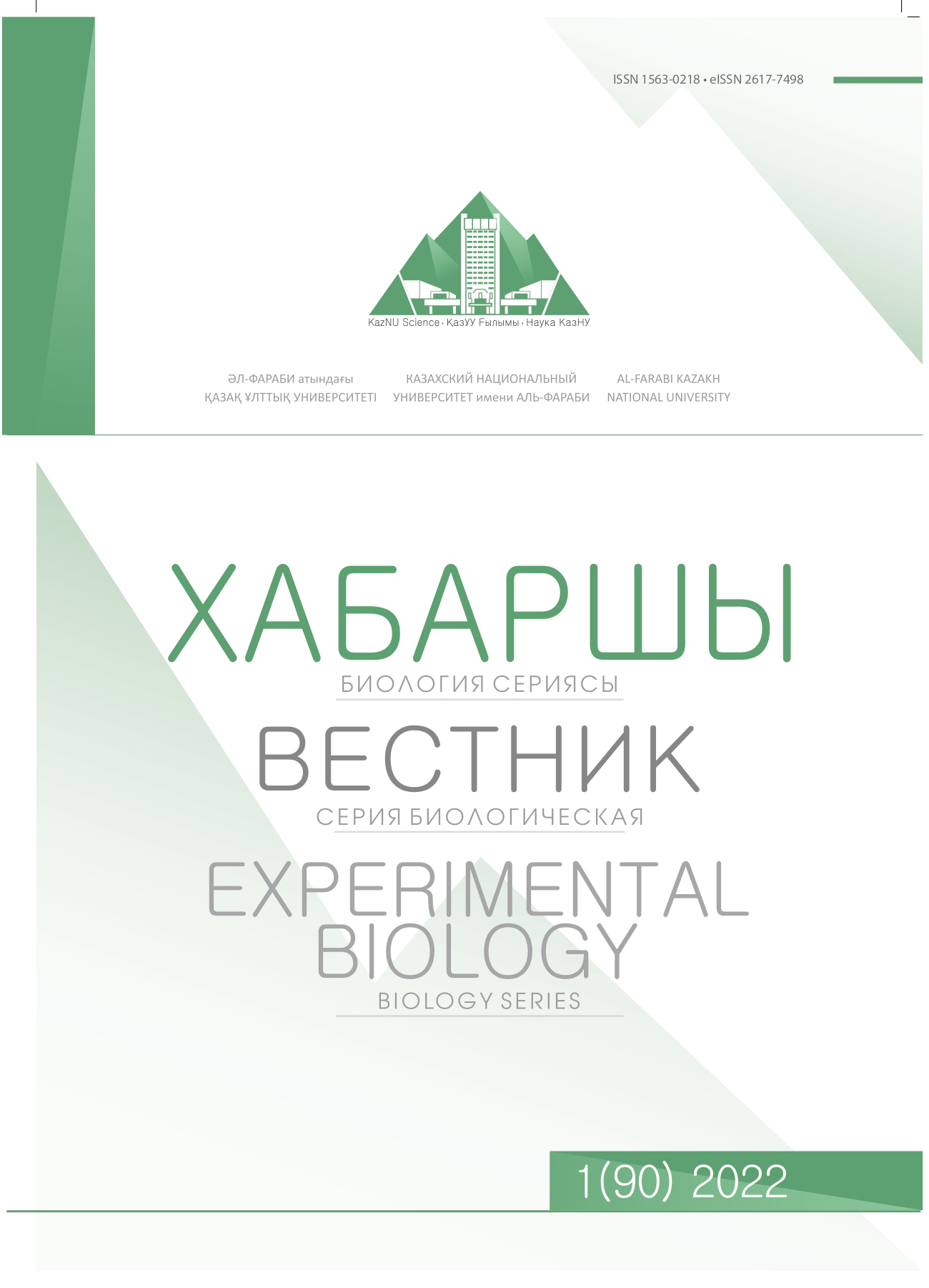БИОТЕСТИРОВАНИЕ ЭНТОМОПАТОГЕННЫХ ГРИБОВ BEAUVERIA BASSIANA ПРОТИВ БЕЛОКРЫЛКИ (TRIALEURODES VAPORARIORUM): ЛАБОРАТОРНЫЕ И ПОЛЕВЫЕ ЭКСПЕРИМЕНТЫ
DOI:
https://doi.org/10.26577/eb.2022.v90.i1.05Аннотация
В настоящем исследовании проводился поиск состава дешевых питательных сред и выращивание на них местных изолятов Beauveria bassiana (Ascomycota: Clavicipitaceae), выделенных их разных природных источников Кыргызстана. Для выращивания биомассы из штаммов Beauveria bassiana в лабораторных условиях и определения ее энтомопатогенной активности были использованы отходы пищевой промышеленности: гороховая крупа, овсяная крупа и соевая мука. Штаммы 501 Вв, 502Вв и 503Вв дали хороший рост мицелия и конидионошение на поверхности овсяной крупы и горохой крупы, при подсчете образующихся конидий в 1г полученной биомассы, плотность конидий составила в течение 15 дней 1.2-1.4 х109спор\мл. Слабый рост был отмечен на соевой муке, количество конидий составила 1.0х104 спор\мл. Результаты in vitro биотестирования полученных биопрепаратов на гороховой и овсяной крупе показали, что из всех испытанных штаммов, 502Bb проявил более высокую эффективность в отношении обоих стадий вредителя (92.00 ±1.13% у личинок и 65.0 ±0.89% у имаго, Р≤0.05) при дозе 1 х 109 конидий/мл.
Библиографические ссылки
Aung O. M., Soytong K., Hyde K. D. Diversity of entomopathogenic fungi in rainforests of Chiang Mai Province, Thailand
//Fungal Diversity. – 2008. – Vol. 30. – P. 15–22.
Boucias D. G. Microbiota in insect fungal pathology //Applied microbiology and biotechnology. – 2018. – Vol. 102. – no. 14. – P. 5873–5888.
Costs of Inaction on the Sound Management of Chemicals // Electronic resource UNEP Official website. – 2013. URL: http://www.unep.org/chemicalsandwaste/
de Faria M. R., Wraight S. P. Mycoinsecticides and mycoacaricides: a comprehensive list with worldwide coverage and international classification of formulation types //Biological control. – 2007. – Vol. 43. – no. 3. – P. 237–256.
Fan Y. Regulatory cascade and biological activity of Beauveria bassiana oosporein that limits bacterial growth after host death //Proceedings of the National Academy of Sciences. – 2017. – Vol. 114. – no. 9. – P. E1578–E1586.
Glare T. Have biopesticides come of age? //Trends in biotechnology. – 2012. – Vol. 30. – no. 5. – P. 250–258.
Goettel, M.S., Eilenberg, J., Glare, T.R. Entomopathogenic fungi and their role in regulation of insect populations. In: Gilbert, L.I., Gill, S.S. (Eds.), Insect Control: Biological and Synthetic Agents //Academic Press, London. – 2010. – P. 387–432.
Gouli V., Gouli S., Kim J. S. Production of Beauveria bassiana air conidia by means of optimization of biphasic system technology //Brazilian Archives of Biology and Technology. – 2014. – Vol. 57. – P. 571–577.
Hill D. S. Pests of crops in warmer climates and their control. – Springer Science & Business Media, 2008.
Javed K. efficacy of Beauveria bassiana and Verticillium lecanii for the management of whitefly and aphid //Pakistan Journal of Agricultural Sciences. – 2019. – Vol. 56. – no. 3. P. 274–287.
Jon A. Martin & Laurence A. Mound. An annotated check list of the world's whiteflies (Insecta: Hemiptera: Aleyrodidae)
// Zootaxa : journal. – 2007. – Vol. 1492. – P. 1–84. – ISBN 978-1-86977-112-6.
Kapongo J. P. Optimal concentration of Beauveria bassiana vectored by bumble bees in relation to pest and bee mortality in greenhouse tomato and sweet pepper //BioControl. – 2008. – Vol. 53. – no. 5. – P. 797–812.
Keyhani N. O. Lipid biology in fungal stress and virulence: Entomopathogenic fungi //Fungal biology. – 2018. – Vol. 122.
– no. 6. – P. 420–429.
Ortiz-Urquiza A., Keyhani N. O. Action on the surface: entomopathogenic fungi versus the insect cuticle //Insects. – 2013.
– Vol. 4. – no. 3. – P. 357–374.
Ortiz-Urquiza A., Luo Z., Keyhani N. O. Improving mycoinsecticides for insect biological control //Applied microbiology and biotechnology. – 2015. – Vol. 99. – no. 3. – P. 1057–1068.
Pedrini N. Targeting of insect epicuticular lipids by the entomopathogenic fungus Beauveria bassiana: hydrocarbon oxidation within the context of a host-pathogen interaction //Frontiers in microbiology. – 2013. – Vol. 4. – P. 24.
Pedrini N., Crespo R., Juárez M. P. Biochemistry of insect epicuticle degradation by entomopathogenic fungi //Comparative Biochemistry and Physiology Part C: Toxicology & Pharmacology. – 2007. – Vol. 146. – no. 1-2. – P. 124–137.
Quesada-Moraga E. Selection of Beauveria bassiana isolates for control of the whiteflies Bemisia tabaci and Trialeurodes vaporariorum on the basis of their virulence, thermal requirements, and toxicogenic activity //Biological control. – 2006. – Vol. 36.
– no. 3. – P. 274–287.
Shcherbakov D. The most primitive whiteflies (Hemiptera; Aleyrodidae; Bernaeinae subfam. nov.) from the Mesozoic of Asia and Burmese amber, with an overview of Burmese amber hemipterans // Bulletin of the British Museum (Natural History). Geology. – 2000. – Vol. 56, no. 1. – P. 29–37.
St Leger R. J., Wang C. Genetic engineering of fungal biocontrol agents to achieve greater efficacy against insect pests // Applied Microbiology and Biotechnology. – 2010. – Vol. 85. – no. 4. – P. 901–907.
St Leger R. J., Wang C. Genetic engineering of fungal biocontrol agents to achieve greater efficacy against insect pests // Applied Microbiology and Biotechnology. – 2010. – Vol. 85. – no. 4. – P. 901–907.
Tarocco F. Optimization of erythritol and glycerol accumulation in conidia of Beauveria bassiana by solid-state fermentation, using response surface methodology //Applied microbiology and biotechnology. – 2005. – Vol. 68. – no. 4. – P. 481–488.
Valero-Jiménez C. A. Genes involved in virulence of the entomopathogenic fungus Beauveria bassiana //Journal of Invertebrate Pathology. – 2016. – Vol. 133. – P. 41–49.
Wraight, S.P., G.D. Inglis and M.S. Goettel. Fungi. In: Lacey, L.A., Kaya, H.K. (Eds.), Field Manual of Techniques in Invertebrate Pathology: Application and Evaluation of Pathogens for Control of Insects and Other Invertebrate Pests// Springer, Dordrecht, the Netherlands. – 2007, – P.223–248.
Wright M. S., Lax A. R. Improved mortality of the Formosan subterranean termite by fungi, when amended with cuticle- degrading enzymes or eicosanoid biosynthesis inhibitors //Folia microbiologica. – 2016. – Vol. 61. – no. 1. – P. 73–83.




